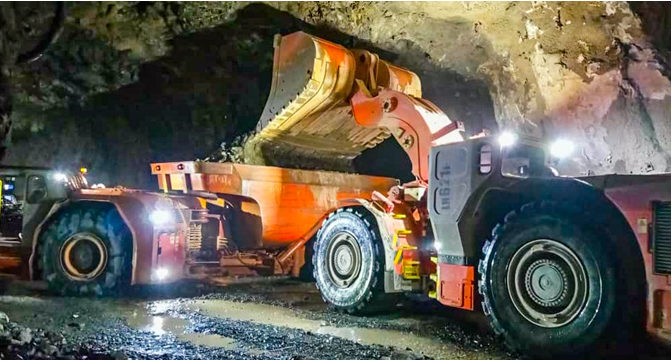Ivanhoe Mines Co-Chair Robert Friedland has hinted in its latest announcement that the Kamoa-Kakula project, in the Democratic Republic of the Congo, could produce first copper ahead of its planned September quarter 2021 schedule.
Friedland and fellow Co-Chair, Yufeng “Miles” Sun, said underground development at the Kakula copper mine continued to exceed expectations with more than 18.7 km now complete – 5.5 km ahead of schedule.
In July, the mining team achieved 1,638 m of underground development, which was 257 m ahead of plan for the month.
Ivanhoe says the Kamoa-Kakula project is unique as it combines ultra-high copper grades in thick, shallow and relatively flat-lying deposits – allowing for large-scale, highly-productive, mechanised underground mining operations.
Initial production at the Kakula mine is scheduled for the September quarter of 2021, with Kakula projected to be the world’s highest-grade major copper mine with an initial mining rate of 3.8 Mt/y at an estimated average feed grade in excess of 6% Cu over the first five years of operation.
The mine will have one of the most favourable environmental footprints of any tier-one copper mine, according to Ivanhoe. “It will be powered by clean, renewable hydroelectricity and be among the world’s lowest greenhouse gas emitters per unit of copper produced,” the company said. “It also will have a relatively tiny surface footprint as approximately 55% of the mine’s tailings will be pumped back into underground workings.” The latter is through a paste backfill plant that Beijing-based CITIC Construction is constructing.
The majority of the development headings at the Kakula mine currently are traversing medium-grade sections of the orebody, with average grades ranging between 3-5% copper. Several development headings are in higher-grade zones averaging between 5-8% copper, and this ore is being placed on a dedicated, high-grade surface stockpile at Kakula North that currently totals some 116,000 t grading an estimated 6.08% Cu. The lower-grade surface stockpiles at Kakula North, Kakula South and Kansoko together contain an additional 446,000 t grading an estimated 2.73% Cu.
As Kakula’s underground development progresses over the next few months, most of the working areas are expected to transition into the higher-grade ore zones near the centre of the deposit that have copper grades approximately 5-8%, Ivanhoe said.
Meanwhile, the high-capacity ore conveyor system at the Kakula North declines, which has a capacity of 2,000 t/h, is undergoing final commissioning and is expected to begin continuous operations shortly. Once this happens, the ore mined in the northern portion of the Kakula mine will be combined and placed on a blended surface stockpile. The Kakula South and Kansoko declines are not equipped with conveyor systems; as such, the ore mined from these deposits will continue to be placed on separate surface stockpiles, based on copper grades.
More than 300 truckloads, consisting mainly of structural steel and equipment for Kakula’s initial 3.8 Mt/y processing plant, are expected to arrive at the mine site before the end of August. Fabrication of the plant’s largest components – two ball mills, each measuring 9.75 m long and 6.1 m in diameter – has been completed at CITIC Heavy Industries’ factory in Luoyang, China, and the third and final shipment of ball mill components is expected to be on site by the end of September.
“The construction team at Kakula, led by Mark Farren, Kamoa Copper’s CEO, has done a fantastic job of keeping the project moving ahead at a rapid pace despite the logistical challenges posed by COVID-19,” Friedland said. “With each passing month, we are getting increasingly confident that we could be producing copper at Kakula ahead of schedule.
“We’re in a good place at the moment, with the vast majority of the major equipment needed to build the mine and processing plant already fabricated, and either at site, or en route to site. Full credit goes to our entire team for implementing and adhering to early and extraordinary measures to safeguard our workforce and mitigate the impact of COVID-19 on the mine development and construction operations.”
The Kamoa-Kakula copper project is a joint venture between Ivanhoe Mines (39.6%), Zijin Mining Group (39.6%), Crystal River Global Limited (0.8%) and the DRC government (20%).
The independent Kakula definitive feasibility study (DFS) and an updated Integrated Development Plan (IDP) for the entire Kamoa-Kakula mining complex is expected to be finalised shortly, Ivanhoe said. The IDP will include details on the planned expansion phases for the greater Kamoa-Kakula mining complex, incorporating updates for mineral resources, production rates and economic analysis.
Basic engineering design and costing for Kamoa-Kakula’s planned Phase 2 expansion, taking production from 3.8 Mt/y to 7.6 Mt/y, is also complete. The scope of facilities for Phase 2 includes underground expansion at the Kakula mine to reach an annual production rate of 6 Mt/y, the expansion of mining operations at the Kansoko mine to a steady state 1.6 Mt/y, a second 3.8 Mt/y concentrator plant at Kakula, as well as associated surface infrastructure to support the expansion at the various sites.











